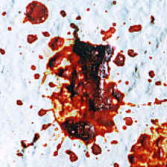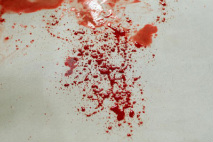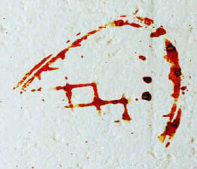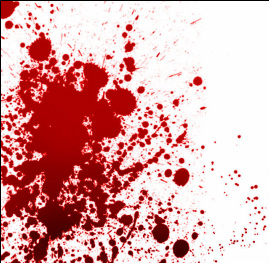Bloodstain Pattern Analysis (BPA)
Facts About Blood
- Blood accounts for 8% of your total body weight, 5 to 6 liters of blood for males, 4 to 5 liters for females
- A 40% blood volume loss (internally and/or externally) is required to produce irreversible shock (death)
- Blood loss of 1.5 liters (internally or externally) is needed to cause the loss of consciousness
- The three categories of bloodstains are Passive, Projected, and Transfer
Passive Bloodstains
Passive bloodstains are drops created or formed by the force of gravity acting alone. Passive bloodstains can be further subdivided to include drops, drip patterns, pools, and clots.
Passive Bloodstain

Passive Bloodstain on a rough surface (such as wood or concrete)
Projected Bloodstains
Projected bloodstains happen when some form of energy has been transferred to a blood source (such as a human victim). Different types of Projected bloodstains are
- Low Velocity Impact Spatter (LVIS) caused by a low velocity impact/force to a blood source
- Medium Velocity Impact Spattter (MVIS) caused by a medium velocity impact/force to a blood source. A beating usually causes this type of blood spatter
- High Velocity Impact Spatter (HVIS) caused by a high velocity impact/force to a blood source. A gunshot or high-speed machinery can cause these types of spatters.
- Cast-Off Pattern is created when blood is released or thrown from the blood-bearing object while in motion.
- Arterial Spurting (or Gushing) Pattern results when blood exits the body under pressure from an open artery.
- Back Spatter is a spatter caused when blood is directed toward the source of energy/force that created the spatter
- Expiratory Blood is blood spatter that is blown out of the nose, mouth, or a wound as a result of air pressure and/or air flow which propells the force
Projected Bloodstain

Projected Bloodstain, possibly a Cast-Off Pattern or a HVIS. The horror movie type blood that is sprayed across a door or a wall from a victim is similar to this type of spatter.
Transfer Bloodstains
Transfer bloodstains occur when an object with blood comes in contact with an object or surface that doens't have blood. It may be possible to recongnize the object that left the bloodstain with the blood impression it left. Different types of Transfer bloodstains are:
- Wipe Pattern which is created when an object moves through an existing stain and alters or removes it appearance.
- Swipe Pattern which is the transfer of blood from a moving source onto an unstained surface. Direction of travel may also be determined by the "feathered edge"
Transfer Bloodstain

Transfer Bloodstain with the imprint of the bottom of a shoe. This Transfer Bloodstain is a Swipe Pattern.
Bloodstain Pattern Anaylsis in Physics
Bloodstain Pattern Analysis can be used as verifiable evidence in court cases and can tell many facts about the possible and impossible situations that could/couldn't have occured such as:
- Determining the weapon used
- The specific impact of said weapon to the blood source
- Where the victim was at the time of the crime
- Where the assailant was at the time of the crime
- If the evidence found in the bloodstain patterns were congruent with those found by the medical examiner
Page by Celeste Giglio

